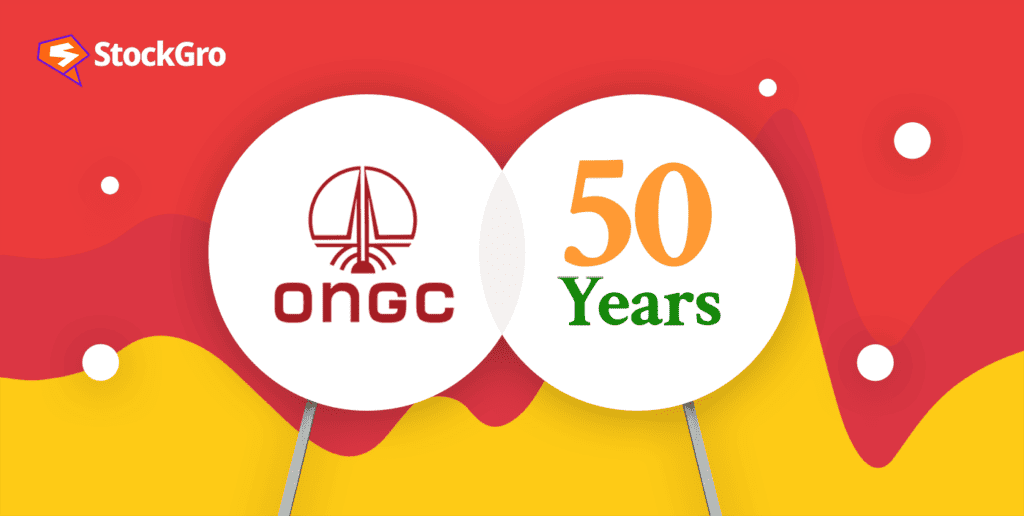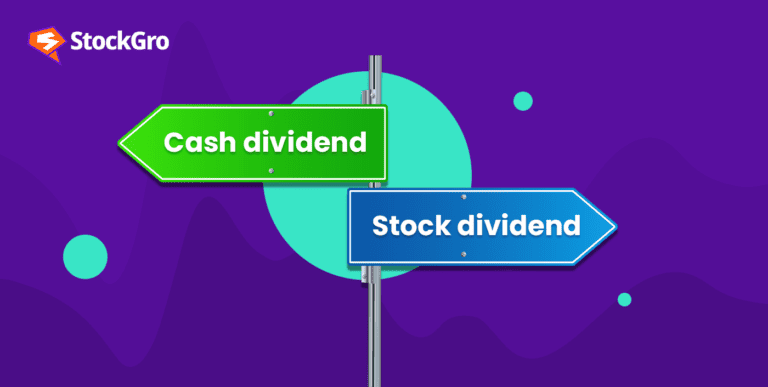
As India’s energy needs grow, the role of oil and gas PSUs like ONGC becomes increasingly strategic. ONGC’s full form is Oil and Natural Gas Corporation, which supplies the majority of India’s domestic crude output through assets like its crown jewel, Mumbai High.
About 71% of India’s domestic output comes from ONGC, making it one of the most significant names in the crude oil and natural gas sector of India.
With ONGC’s Mumbai High marking 50 successful years, let’s look at the company’s history, performance milestones, financials, and dividend payouts in today’s article.
Also read: Fueling India’s growth engine: Evolution and outlook of oil & gas industry
About ONGC
With his forward-thinking leadership, Pandit Jawahar Lal Nehru established ONGC in 1956. The Oil and Natural Gas Commission became a corporation in 1994 and was named a Navratna by the Indian government in 1997. It was eventually granted Maharatna status in 2010.
Gas Authority of India Limited (GAIL), Indian Oil Corporation (IOC), and ONGC all reached an agreement in March 1999 to hold shares in each other’s companies. As a result, local and international energy value chain companies were able to establish long-term strategic agreements with one another.
ONGC Videsh Ltd. (OVL) is ONGC’s subsidiary that has expanded into international markets. Investments in Vietnam brought in ONGC’s earliest hydrocarbon revenue from outside the country. The company has since made substantial investments in Sakhalin, Columbia, Venezuela, Sudan, etc.
ONGC’s energy exploration efforts extend beyond the Krishna Godavari Basin and the discovery of new energy prospects. Over its 60 years of glory, ONGC has accomplished much, helping India fulfil its energy goals.
ONGC dividend history
ONGC’s dividend history can be divided into specific phases, reflecting its performance and profitability. The first phase (2000-2010) saw decent dividends with an increasing trend that ranged from 25% to 320%.
The second phase (2011-2018) maintained a high level of dividends with moderate payout ratios, such as going from 15% in 2011 to 100% in 2020.
The third phase (2019-2024) experienced a reduction in dividends due to the impact of the COVID-19 pandemic and the decline in oil prices. During this period, the dividend ratio ranged from 35% to 80%.
ONGC news update: Mumbai High’s continued success after 50 years
Hardeep Singh Puri, the Petroleum Minister, praised Mumbai High’s fifty years of dedicated service and called it a national gem during the Golden Jubilee Celebrations.
2024 marks 50 years since the discovery of Mumbai High, India’s renowned and most significant oilfield. While most oilfields from that time have stopped producing, Mumbai High in the Arabian Sea continues to thrive.
In the last half-century, Mumbai High has generated 527 million barrels of oil and 221 billion cubic metres of gas, which accounts for about 70% of India’s domestic output to this point.
Production on the Mumbai High Field began on May 21, 1976. The field’s production increased from 3,500 bpd to 80,000 bpd in only three years. At present, its oil production is at 1,35,000 bpd and its gas production is around 13 bcm.
Oil and gas have continued to flow at Mumbai High thanks to four redevelopment schemes that have received enormous amounts of investment.
The field has production potential for at least a few more years because of its remaining reserves. Its total reserves were around 1.659 billion tonnes.
Given Mumbai High’s long and rich history in India’s gas and oil industry, Minister Puri stressed the importance of the location in directing future exploration efforts. The chairman expressed confidence about the possibility of finding a new field similar to Mumbai High soon and intended to increase production plans and exploration expenses.
Also read: Exploring Gujarat Gas Ltd. (GGL)
ONGC’s competitors
Here are some of the competitors of ONGC (as of February 21, 2023) ranked by market capitalisation (₹ cr.):
- Reliance Industries Ltd. (2,012,718.60)
- Oil India Ltd. (65,807.13)
- Petronet LNG Ltd. (42,202.50)
- Hindustan Oil Exploration Company Ltd. (2,683.22)
Financials
On Tuesday, February 10, 2024, ONGC’s share price hit a high point that hadn’t been seen in over nine years. Since October 10, 2014, ONGC shares have never been higher than ₹281.15. They went up as much as 2.37%. The ONGC share rate was 277.35 rupees at 09:55 a.m., a 0.98% increase.
| Metric | Value |
| Market capitalisation (₹ Cr.) | 349,354.35 |
| Book value per share (₹) | 143.96 |
| Dividend Yield | 4.05% |
| ROCE | 13.9 % |
| ROE | 12.62% |
| Face value (₹) | 5 |
Investing in ONGC
Pros
- ONGC is well-established in the Indian and global markets and has a diverse range of oil and gas assets. As a result, the business can stand out from the competition.
- ONGC is putting money into creative endeavours and technology to increase output and reserve capacity. Renewable energy, green hydrogen, green ammonia, and other green hydrogen derivatives are just a few examples of the low-carbon energy potential that ONGC is aggressively pursuing via partnerships with major businesses.
- ONGC has maintained a strong reserve replacement ratio of more than 1x over the last 17 years, and its reserves have an average life of more than 15 years, which shows that its producing reserves are sustainable. This shows that it can keep producing at its current level going forward.
- ONGC’s PE ratio of 8.50 is below its sector average of 10.57. This indicates that ONGC’s current price is lower than its true worth and that there is potential for further appreciation.
Cons
- The cyclicality and volatility of oil and gas prices affect ONGC’s bottom line and revenue generation. It is also up against both local and international competitors.
- ONGC’s amount of debt, at ₹1,435.0 billion, might restrict its ability to develop and adjust financially. Additionally, it has to deal with social and environmental risks that are linked to its operations.
Also read: Everything you need to know about Crude oil trading in India
Shareholding pattern of ONGC
The shareholding pattern (as of December 2023) of ONGC is as follows:
Promoters: 58.89%
Foreign Institutional Investors (FIIs): 9.2%
Domestic Institutional Investors (DIIs): 29.03%
Public: 2.89%
Conclusion
With its reserves, technologies, and global footprint, ONGC is well-positioned to continue driving India’s energy security. However, with mounting competition and the push for clean energy, ONGC needs to continue adapting its strategy.
For investors, ONGC offers stability but requires analysing risks from oil markets, the execution of new initiatives and competition.
